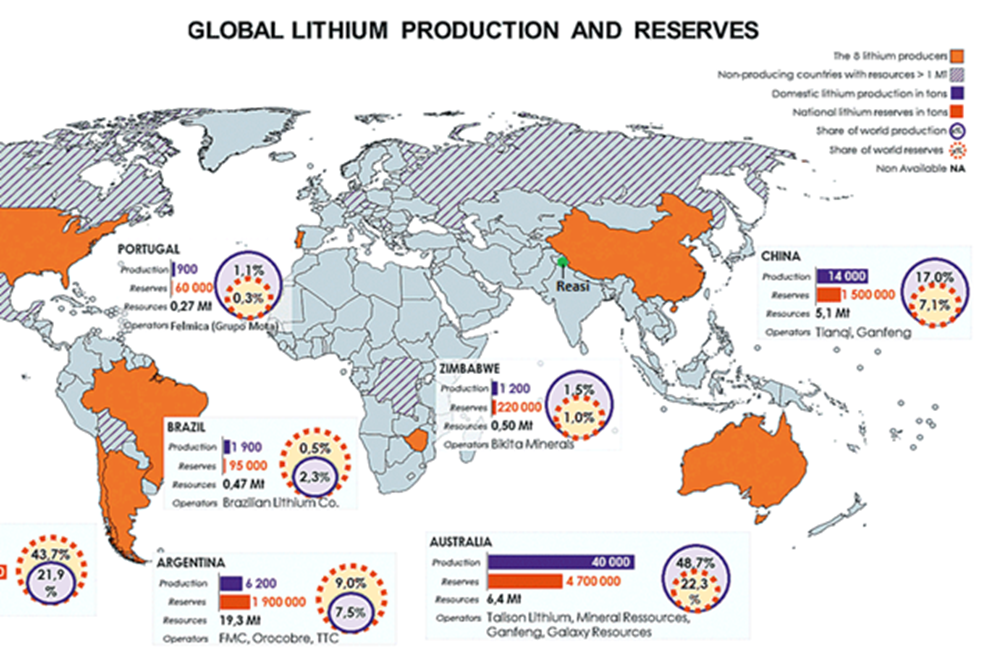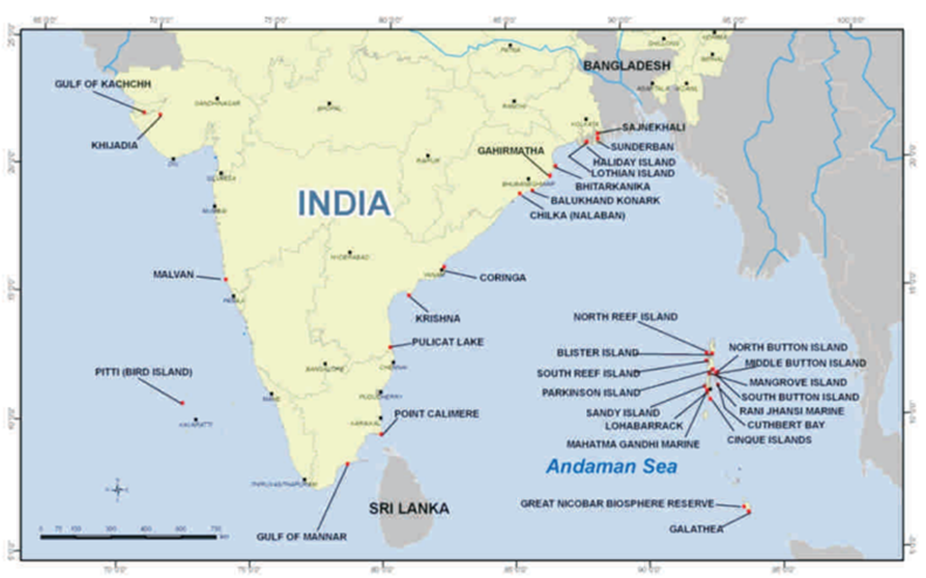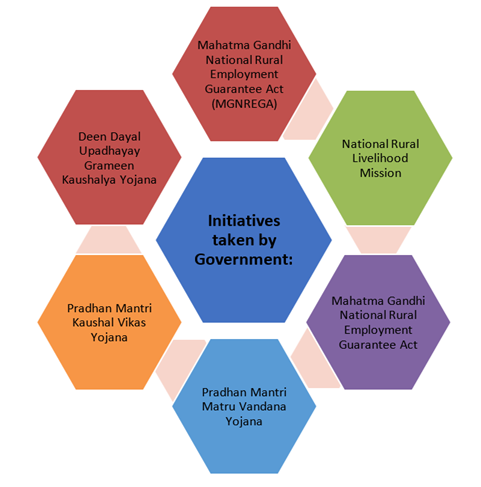Wednesday, 15th February 2023
Constitutional Oath is not a mere formality
In News: Constitution is the basic law that lays the foundation for the governance of a country. Basic eligibility criteria for appointment to several high constitutional offices are prescribed in the Constitution. Yet, many silent disqualifications operate. These are implied and read into the eligibility criteria by courts, solely guided by the objective of upholding the Constitution and the law and the integrity of the institution for which the functionary is chosen.
Importing a Disqualification:
- In B.R. Kapur v. State of Tamil Nadu (2001), the Governor’s appointment of Jayalalithaa as Chief Minister despite her conviction for a criminal offence was called in question and it was declared unconstitutional by the Supreme Court.
- The oath to be taken by a judge of a High Court under Schedule III of the Constitution requires a declaration of allegiance to the Constitution and performance of duties “without fear or favour, affection or ill-will”.
- The appointee must also declare that she will “uphold” the Constitution and the laws. Such an oath is unique to the judges of the High Court and the Supreme Court, since they are the sentinels of the Constitution. The oath is a solemn assurance to the people that justice will be rendered without any bias.
Adhering to the Oath:
- An additional judge of the High Court, who was not appointed as a permanent judge due to allegations of lack of probity, was later recommended by the then Chief Justice of the Madras High Court for appointment as president of the State Consumer Commission. The appointment was declared illegal by the Supreme Court.
- In N. Kannadasan v. Ajoy Khose (2009) case the Supreme Court declared “Eligibility of a judge of a High Court should not be construed in a pedantic manner.”
- In this case, Supreme Court held that an independent and impartial judiciary should be manned by persons who dispense justice “without fear or favour, ill-will or affection.” It held that a person who lacked the qualities necessary to adhere to the oath of office of a judge was ineligible for appointment to any judicial office.
Selection of judges:
- To limit ‘eligibility’ for appointment of a High Court judge to a minimum of 10 years of legal practice prescribed in Article 217(2) makes a mockery of the integrity and independence of the judiciary. Such a facile reading turns the solemn assurance of an impartial and fair judiciary into a hollow promise.
- Faced with opacity in judicial appointments/ transfers, the Supreme Court in S.P. Gupta v. Union of India (1981) directed the Government and the Chief Justice of India (CJI) to disclose all the materials. The judges held that their constitutional duty demanded such scrutiny through judicial review. They also held that if on scrutiny it was found that all the materials were not before the CJI (now collegium), the consultation/ selection process is defective and invalid.
Transparency and accountability in the selection of judges alone will ensure an independent judiciary. The Preamble to the Constitution should permeate selection of every judge.
https://www.thehindu.com/opinion/op-ed/constitutional-oath-is-not-a-mere-formality/article66505210.ece
Unplanned Urban Planning - Edukemy Current Affairs
In News:
From Joshimath to Panjim, India’s flawed urban journey points to the need for having a multi-generational process in place that considers the impact of climate change and extreme weather.
About the News:
When planned townships are approved, with a distinct lack of concern for natural hazards, disasters are bound to occur.
Water shortage
- In 2009, a tunnel boring machine in Joshimath, Uttarakhand, hit an aquifer about three kilometers from Selang village. This resulted in the loss of nearly 800 liters of water per second (enough to sustain the needs of nearly 30 lakh people per day). Groundwater sources began drying up even as the water flow reduced but never stopped.
- Joshimath also has no system to manage wastewater.
Land subsidence
- An estimated 6% of India’s land area is prone to landslides, especially in Sikkim, West Bengal and Uttarakhand.
- Construction in such a landscape is often driven by building by-laws that ignore local geological and environmental factors.
- Soak-pit mechanism in Joshimath could exacerbate the land sinking. The Tapovan Vishnugad dam and the Helang-Marwari bypass road may also worsen the situation.
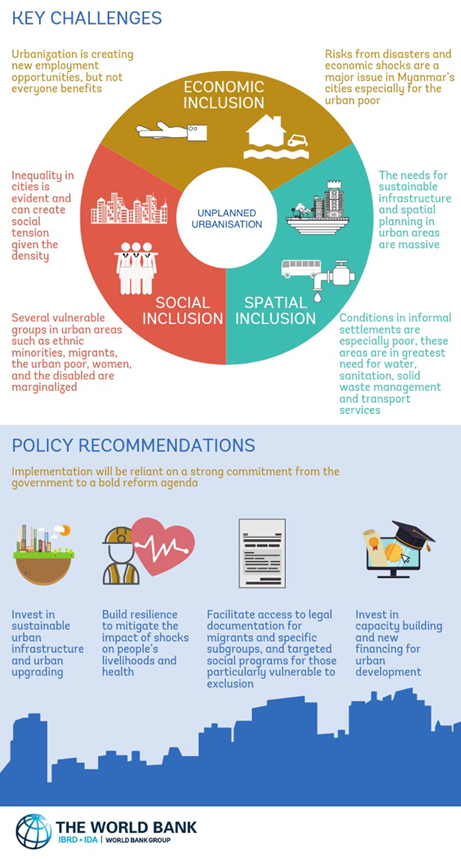
Flooding
- Dombivali, Maharashtra in 2019: With seasonal rain increasing in intensity, the township flooded because it was built on the flood plains of the Mothali river.
- Panjim, Goa in 2021: Urban settlements along the Mandovi river, built on marshlands, were once home to mangroves and fertile fields, which helped bolster its flood resilience.
How to mitigate landslides in urban hills?
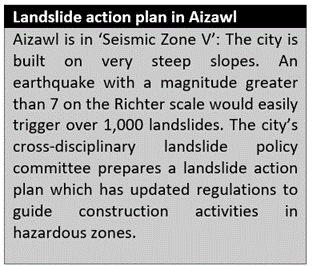
- Acquiring credible data: The overall landslide risk needs to be mapped at the granular level. The Geological Survey of India has conducted a national mapping exercise.
- Landslide action plan: Areas with high landslide risk should not be allowed to expand large infrastructure.
- Hazardous zone assessment: It should be done by a geologist with respect to soil suitability and slope stability.
- Early warning system: In Gangtok, the Amrita Vishwa Vidyapeetham has helped set up a real-time landslide monitoring and early warning system, with sensors assessing the impact of rainfall infiltration, water movement, and slope instability.
How to mitigate floods in urban areas?
- Enhancing sewerage and stormwater drain networks: Existing sewerage networks need to be reworked and expanded to enable wastewater drainage in low-lying urban geographies.
- Desilting of Rivers that overflow.
- Coastal walls need to be built in areas at risk from sea rise.
- Flood-resilient architecture: river embankments, flood shelters in coastal areas and flood warning systems are necessary.
- Protecting “blue infra” areas: These are places that act as natural sponges for absorbing surface runoff, allowing groundwater to be recharged, is a must.
- Simulation capacity building: As rainfall patterns and intensity change, urban authorities will need to invest to determine flooding hotspots and flood risk maps.
Source:
https://www.thehindu.com/opinion/op-ed/hill-or-city-urban-planning-cannot-be-an-afterthought/article66505460.ece
Climate-linked Lightning Raises Global Wildfire Risk: Study
In News: A study published in Nature Communications has recently found that Climate change has increased the frequency of lightning strikes throughout the world. An increase in the frequency of lightning has led to a higher risk of lightning-induced wildfires in the future.
Major findings of the study:
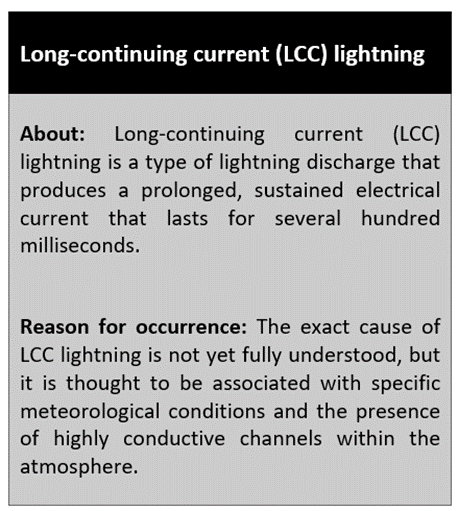
- Total lightning incidences have gone up 43% globally, with a 41% increase in long-continuing current (LCC) lightning.
- Lightning incidents on land have gone up by almost half which is an almost 47% increase in LCC lightning over land.
- The largest increase in LCC lightning was observed in South America, the western coast of North America, Central America, Australia, Southern and Eastern Asia, and Europe.
- A decreased risk of lightning-caused wildfires in the polar regions has been predicted for the 2090s, except in some small areas in Scandinavia, Alaska, and Siberia, where the risk could be elevated due to an increase in LCC lightning.
- The researchers estimate that a large increase in lightning-caused wildfires will be along the Mediterranean basin and on North America’s western and central coasts in the 2090s.
- The likelihood of ignition by LCC lightning is greater than ignition by lightning without continuing currents.
- Variations in lightning frequency and meteorological factors have influenced the susceptibility of lightning-caused wildfires to climate change.
Challenges:
- Climate change worsens wildfires by increasing drought, high air temperatures, low relative humidity, lightning, and strong winds resulting in hotter, drier, and longer fire seasons.
- Wildfires worsen climate change by ravaging sensitive and carbon-rich ecosystems like peatlands and rainforests, making it harder to halt rising temperatures.
- Sustained electrical current in LCC lightning is more likely to cause wildfires than other types of lightning because it creates a spark that ignites dry vegetation.
- The increase in LCC lightning due to climate change is leading to an increase in the number of wildfires, which pose a serious threat to people, wildlife, and ecosystems.
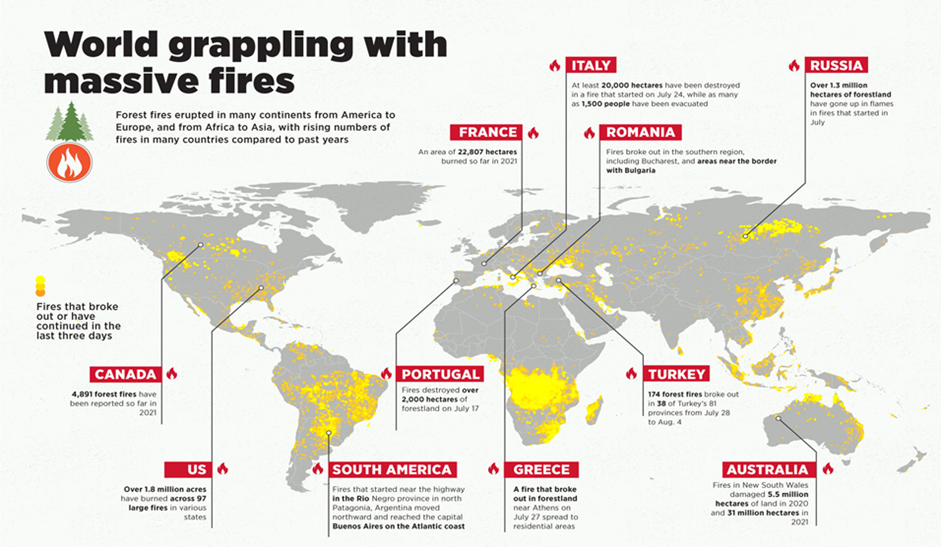
What can be done to reduce its occurrence?
- Climate change mitigation: Reducing greenhouse gas emissions through actions such as transitioning to renewable energy sources and implementing energy efficiency measures.
- Improved lightning detection and prediction: Developing better detection and prediction systems for LCC lightning for early warnings and implementing emergency response measures.
- Vegetation management: Reducing the amount of dry vegetation through practices such as controlled burns and vegetation removal in high-risk areas.
- Fire prevention measures: Implementing fire prevention measures such as fire breaks and proper disposal of cigarettes and other flammable materials.
- Education and awareness: Educating the public about the risks of wildfires caused by lightning and promoting safe practices.
https://www.downtoearth.org.in/news/climate-change/climate-change-related-lightning-strikes-to-spike-wildfire-risk-globally-study-87683
DELIMITATION - Edukemy Current Affairs
In News: The Supreme Court dismissed a challenge to the constitution of the Jammu and Kashmir Delimitation to readjust constituencies in the new Union Territory.
About the Delimitation Commission:
The J&K Reorganisation Act which created the two new Union territories assigns the role of readjustment of constituencies to the Delimitation Commission under the Delimitation Act, 2002.
|
Delimitation Commission Act, 2002 |
|
Delimitation
- It is the act or process of fixing limits or boundaries of territorial constituencies in a country or a province having a legislative body. It is to represent ‘One Vote, One Value’.
Constitution of Delimitation Commission
- The President appoints a Delimitation Commission that works in collaboration with the Election Commission of India. Its members are:
- Chairperson: member who is or has been a Judge of the Supreme Court
- Chief Election Commissioner or an Election Commissioner nominated by the Chief Election Commissioner, ex officio.
- State Election Commissioner of concerned State, ex officio.

Source:
https://www.thehindu.com/news/supreme-court-dismisses-plea-challenging-delimitation-in-jammu-kashmir/article66503117.ece
GEO HERITAGE PROTECTION BILL - Edukemy Current Affairs
In News:
The draft Geo-heritage Sites and Geo-relics (Preservation and Maintenance) Bill gives the Geological Survey of India (GSI), the power to declare sites as having ‘geo-heritage’ value.
About the Geoheritage protection bill:
- Objective: The bill is aimed at protecting India’s geological heritage which includes fossils, sedimentary rocks, and natural structures by declaring the sites as having ‘geo-heritage’ value.
- Key provisions of the bill include granting power entirely to the GSI:
- To declare the sites as having ‘geo-heritage’ value.
- Take possession of relics (fossils, rocks) that rest in private hands.
- Prohibit construction 100 meters around such a site
- Impose penalty with fines up to Rs 5 lakh and possibly imprisonment for vandalism, defacement, and violations of directives of a site.
- India being a signatory to the UNESCO Convention concerning the Protection of the World Cultural and Natural Heritage, since 1972, there is a specific need of a law protecting geo heritage sites.
- GSI has declared 32 geo-heritage sites, including the Siwalik Fossil Park, Himachal Pradesh; Stromatolite Fossil Park, Jhamarkotra Rock Phosphate deposit, Udaipur district, Akal Fossil Wood Park, Jaisalmer, but several are in stages of disrepair.
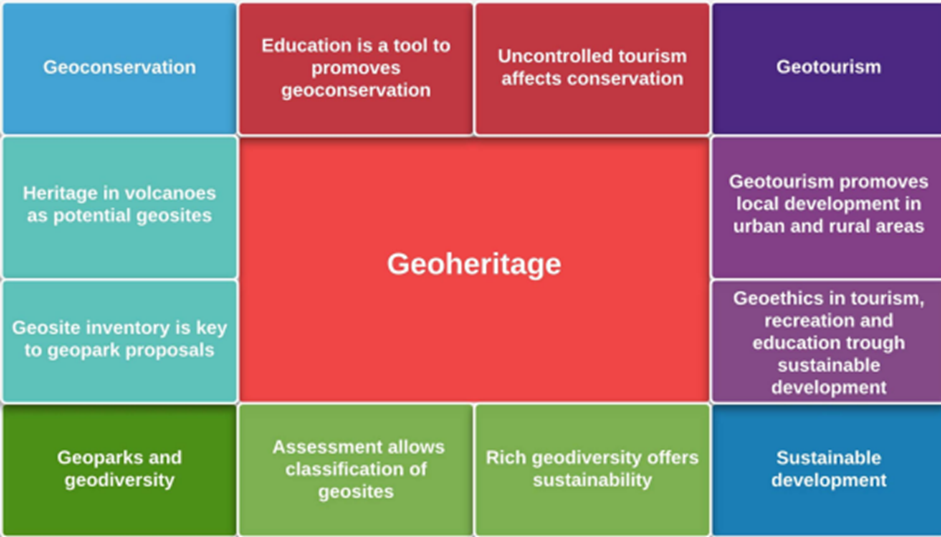
Source:
https://www.thehindu.com/news/national/draft-bill-vests-powers-entirely-in-geological-survey-of-india-say-experts/article66505530.ece#:~:text=and%20palaeontology%20community.-,The%20draft%20Geo%2Dheritage%20Sites%20and%20Geo%2Drelics%20
Dawoodi Bohras - Edukemy Current Affairs
In News: The Supreme Court refers the constitutional validity of the practice of ex-communication in the Dawoodi Bohra community to the 9-judge bench hearing the Sabarimala review petition on essential religious practice.
Key facts:
- The Dawoodi Bohras are a Shia Muslim community primarily based in India, but with a presence in several countries around the world including Pakistan, the Middle East, North America, South East Asia, and Australia.
- The community is believed to have been founded in the 11th century by a scholar named Da'i al-Mutlaq and at present has a population of around 1 million
- The current leader of the Dawoodi Bohras is His Holiness Dr Syedna Mufaddal Saifuddin, who is recognized by the community as the 53rd Al-Dai-Al-Mutlaq.
- The leader of the community has the right to excommunicate its members, which includes not being allowed to access mosques belonging to the community or burial grounds dedicated to the community.
- The Dawoodi Bohras are known for their strict adherence to Islamic traditions and practices, and their unique customs and rituals, which include communal meals, special prayers, and the distribution of a sweet drink called sharbat.
- The community places great emphasis on education, and children are encouraged to pursue higher education and professional careers.
- They are also known for their philanthropic activities, and the community operates a number of charitable institutions, including hospitals, schools, and community centers.
- The community has been criticized by different quarters of civil societies for its inhumane practice of female genital cutting or female genital mutilation (FGM).
- Famous personalities include: Asha Parekh(honored with the Dadasaheb Phalke Award for 2020), Abbas–Mustan etc.
https://indianexpress.com/article/explained/explained-law/who-are-dawoodi-bohras-what-is-excommunication-petition-supreme-court-8437406/
Market Access Initiative (MAI)
Market Access Initiative (MAI) Scheme
In News: Ministry of Textile organizes UPNEXT INDIA under the MAI Scheme
Key points:
- Upnext India is a series of Reverse Buyer Seller meets under the name of “UPNEXT INDIA” with Japan as the first focus country under the initiative.
- It has been organized by AEPC and supported by the Ministry of Commerce and Industry under the Market Access Initiative (MAI) Scheme.
- The first edition of upnext India 2023 has been inaugurated at Apparel House, Gurugram
- The government of India also is coming up with a Production Linked Initiatives (PLI) scheme which will majorly include Ready Made Garment (RMG).
- Japan imported readymade garments worth US$ 23 billion in 2022 while India exported readymade garments worth US$ 0.22 billion to Japan with a meagre share of 0.9%.
- Given that the Indian garment industry is blessed with the largest raw material availability of cotton, jute, silk, and wool in the world, it holds a strong business opportunity in Japan.
Market Access Initiative (MAI) Scheme
- It is an Export Promotion Scheme by Ministry of Commerce and Industry designed to promote India’s exports on a sustained basis.
- The scheme is based on a focus product-focus country approach, which identifies specific markets and products through market studies/surveys.
- Under the scheme, assistance will be provided to Export Promotion Organizations, Trade Promotion Organizations, National Level Institutions and Research Laboratories, Exporters, etc. based on eligible activities.
- Activities eligible for financial assistance under the scheme includes: Marketing Projects Abroad, capacity building and supporting Cottage and handicrafts units etc.,
- Eligible agencies include Departments of Central Government and Organisation of Central/State Governments, Indian Missions abroad, Export Promotion Councils etc., besides national Level Institutions including IITs,IIMs,NIFT, etc.,
https://pib.gov.in/PressReleasePage.aspx?PRID=1898009#:~:text=This%20initiative%20in%20the%20form,Access%20Initiative%20(MAI)%20Scheme
Indian Council of Historical Research (ICHR)
Why in news? Recently the government informed the Lok Sabha, that the ICHR has not launched any project to rewrite Indian history and it is only “filling gaps”.

About:
- ICHR is an autonomous body of the Union Ministry of Education.
- It was established under the Societies Registration Act (Act XXI of 1860) in 1972 by an Administrative Order of the then Union Ministry of Education and Social Welfare.
- It is based in New Delhi with regional centers in Pune, Bengaluru, and Guwahati.
- ICHR disburses funds for carrying out research to Indian as well as foreign scholars on their applications for fellowships, grants, and symposia made to ICHR or through HRD Ministry.
- It has provided financial assistance to historians and direction to research scholars in their multifarious topics of historical research.
https://indianexpress.com/article/india/ichr-not-rewriting-indian-history-only-filling-gaps-govt-8443079/
Diyodar meteorite - Edukemy Current Affairs
Why in news? Scientists from Physical Research Laboratory (PRL), Ahmedabad, are claiming that the meteorite that crashed in two villages in Banaskantha, Gujarat has been identified as an aubrite.

About:
- A meteorite is a celestial object (made of rocks and metals) that enters the atmosphere of the earth and reaches the surface.
- The meteorite is a “rare, unique specimen” of aubrite.
- India has seen hundreds of meteorite crashes, but this is only the second recorded crash of an aubrite. The meteorite has been named the Diyodar meteorite after the taluka in which the villages are located.
Aubrites
- Aubrite meteorite is a coarse-grained igneous rock that formed in oxygen-poor conditions and contains exotic minerals not found on Earth.
- For example, the mineral heideite was first described in the Basti meteorite.
- The last crash of an aubrite before this was in Basti, Uttar Pradesh on December 2, 1852.
- Around 90% of the meteorite was composed of orthopyroxene. Pyroxenes are silicates consisting of single chains of silica tetrahedra (SiO 4); orthopyroxenes are pyroxenes with a certain structure.
https://www.thehindu.com/sci-tech/science/rare-unique-diyodar-meteorite-in-2022-was-indias-first-aubrite-in-170-years/article66496695.ece
Sukanya Samriddhi Account scheme
Why in news? Recently, PM Modi hailed the opening of 10 lakh Sukanya Samridhi Accounts in 2 days.
 About:
About:
- The Sukanya Samriddhi Account scheme is a long-term saving scheme for a girl child.
- It aims to encourage parents to build a fund for the future education and marriage expenses of their daughters.
- The Sukanya Samriddhi Account is opened in the name of a girl child till the child attains the age of 10 years and the account can be opened in post offices and notified branches of commercial banks.
- A deposit of up to ₹1.5 lahks is permitted during a financial year, although the initial deposit can be as low as ₹250, which is also the minimum prescribed during a fiscal year.
- The accounts mature after the girl reaches the age of 21 years or at the time of marriage of the girl in whose name the account has been opened.
- India Post noted that on average annually 33 lakh Sukanya Samriddhi Accounts are opened. In the last eight years, a total of 2.7 crore accounts have been opened.
https://www.hindustantimes.com/india-news/future-of-daughters-pm-modi-hails-opening-of-10-lakh-sukanya-samridhi-accounts-in-2-days-101676185807363.html
Cyprus - Edukemy Current Affairs
Why in news? Recently, The Prime Minister has congratulated H. E. Nikos Christodoulides for being elected as the President of Cyprus.
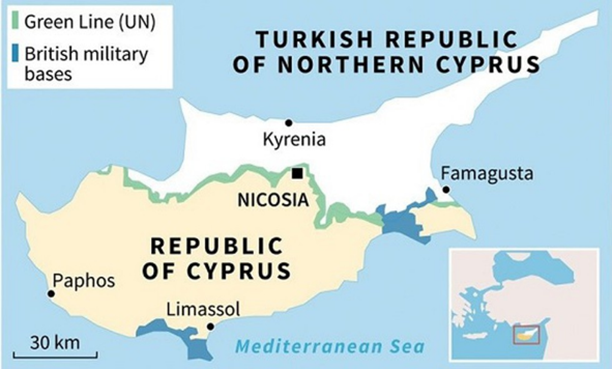
About:
- Cyprus officially called the Republic of Cyprus, is an island country in the eastern Mediterranean Sea.
- It is the third largest and third most populous island in the Mediterranean and is located south of Turkey; west of Syria; northwest of the Gaza Strip, Israel, and Lebanon; north of Egypt; and southeast of Greece.
- The country's capital and largest city is Nicosia.
- Division
- However, the Republic of Cyprus is de facto partitioned into two main parts:
the area under the effective control of the Republic, located in the south and west and comprising about 59% of the island's area, and
-
- the north, administered by the self-declared Turkish Republic of Northern Cyprus, covering about 36% of the island's area.
- Another nearly 4% of the island's area is covered by the UN buffer zone.
https://www.news18.com/news/world/pm-modi-congratulates-christodoulides-on-winning-cyprus-presidential-election-7074889.html
Quasi crystals - Edukemy Current Affairs
In News: Recently, Scientists have discovered a new type of quasicrystal, one with 12-fold symmetry, in the Sand Hills of north central Nebraska, USA.
About
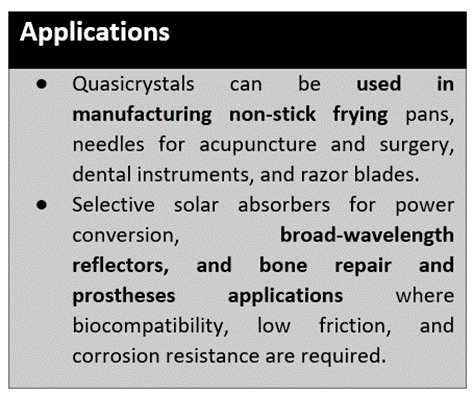
- Quasicrystal is a matter formed atomically in a manner somewhere between the amorphous solids of glasses and the precise pattern of crystals. These crystals consist of atoms that are arranged in a pattern that doesn’t repeat itself regularly.
- Quasicrystals are physical lattices with a translational disorder that retain local, rotational symmetry whereas, 'perfect' crystals have both translational and rotational symmetry and are always close-packed.
- Quasicrystals have been widely created in labs and are known to “possess novel electrical, photonic, and mechanical properties that aren’t found in other materials.
- “The dodecagonal quasicrystal is an example of a quasicrystal of any kind formed by electrical discharge, suggesting other places to search for quasicrystals on Earth or in space and for synthesizing them in the laboratory”
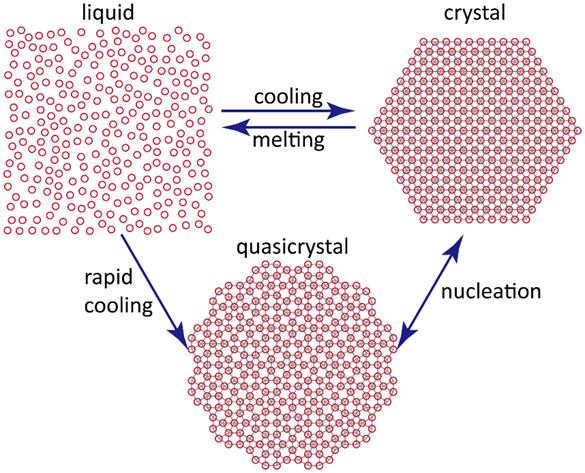
https://indianexpress.com/article/explained/explained-sci-tech/scientists-discover-new-quasicrystal-explained-8440730/
Faster Adoption and Manufacturing of Electric Vehicles - FAME II
Context: The government is looking at the option of increasing the utilization of resources earmarked under the FAME II scheme for electrifying buses.
About
- FAME II is a scheme launched by the Government to give a boost to the development of Electric Vehicles. It is an effort to combat climate change across the globe.
- Under the scheme Rs 10,000 crores for a period of 3 years from 2019 to 2022 was allocated.
- Rs 1,000 crores has been set aside for setting up charging stations for electric vehicles. It has given a proposal of providing 1 slow charging unit for every electric bus and 1 fast charging station for 10 electric buses.
- The Central Government incentivizes the purchase of approximately 5 lakh three-wheelers, 7000 electric buses, and 35,000 four-wheelers.
- Department of Heavy Industries, the Ministry of Heavy Industries and Public Enterprises is the monitoring authority
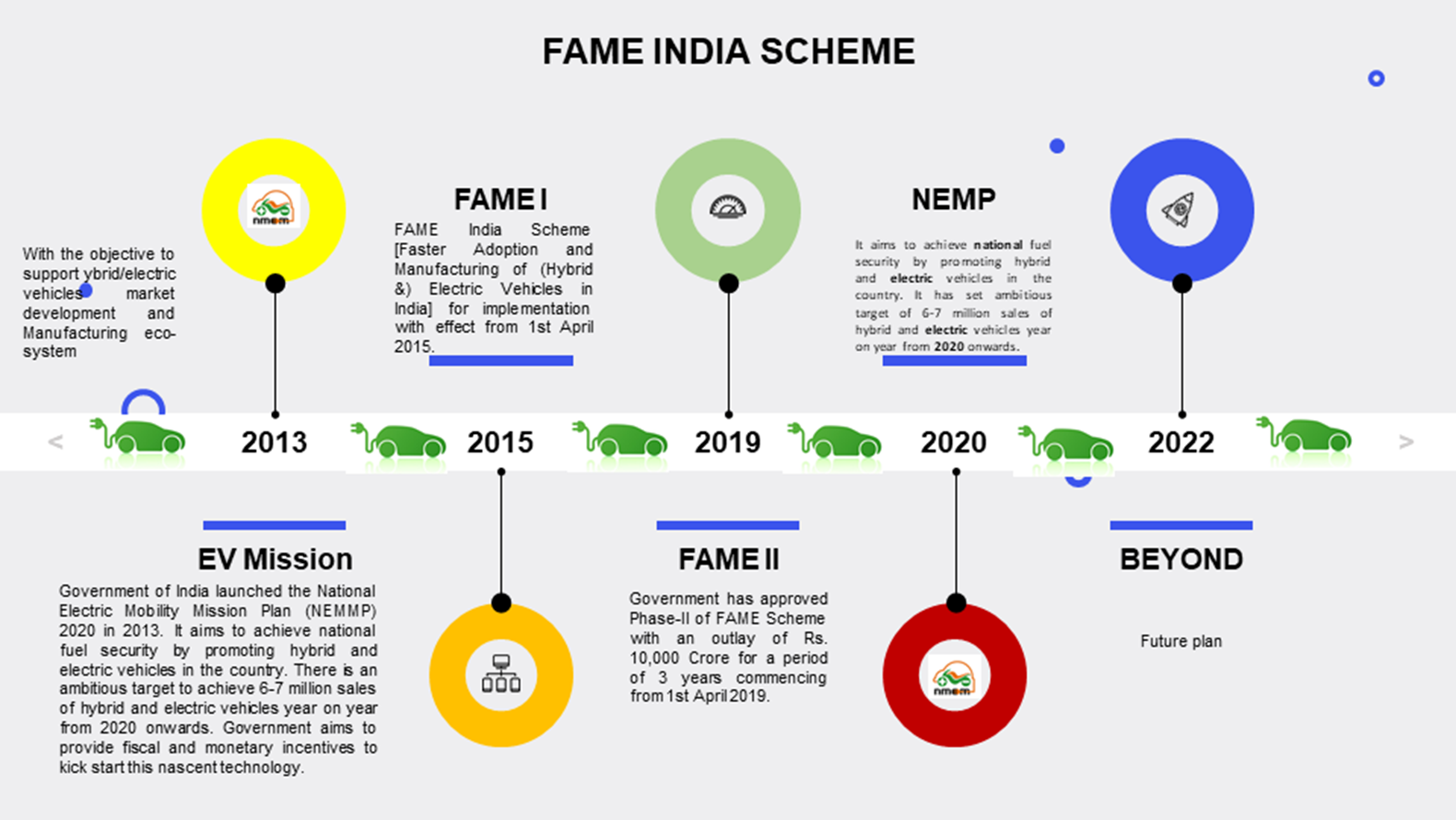
https://economictimes.indiatimes.com/epaper/delhicapital/2023/feb/13/et-front/more-fame-ii-funds-may-go-to-e-buses/articleshow/97847845.cms
Share the article
Get Latest Updates on Offers, Event dates, and free Mentorship sessions.

Get in touch with our Expert Academic Counsellors 👋
FAQs
UPSC Daily Current Affairs focuses on learning current events on a daily basis. An aspirant needs to study regular and updated information about current events, news, and relevant topics that are important for UPSC aspirants. It covers national and international affairs, government policies, socio-economic issues, science and technology advancements, and more.
UPSC Daily Current Affairs provides aspirants with a concise and comprehensive overview of the latest happenings and developments across various fields. It helps aspirants stay updated with current affairs and provides them with valuable insights and analysis, which are essential for answering questions in the UPSC examinations. It enhances their knowledge, analytical skills, and ability to connect current affairs with the UPSC syllabus.
UPSC Daily Current Affairs covers a wide range of topics, including politics, economics, science and technology, environment, social issues, governance, international relations, and more. It offers news summaries, in-depth analyses, editorials, opinion pieces, and relevant study materials. It also provides practice questions and quizzes to help aspirants test their understanding of current affairs.
Edukemy's UPSC Daily Current Affairs can be accessed through:
- UPSC Daily Current Affairs can be accessed through Current Affairs tab at the top of the Main Page of Edukemy.
- Edukemy Mobile app: The Daily Current Affairs can also be access through Edukemy Mobile App.
- Social media: Follow Edukemy’s official social media accounts or pages that provide UPSC Daily Current Affairs updates, including Facebook, Twitter, or Telegram channels.


